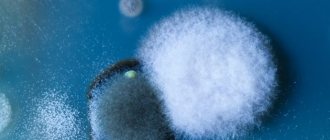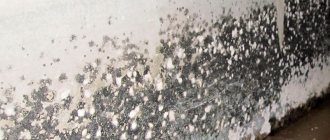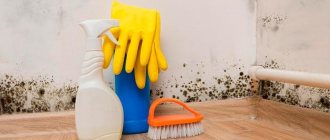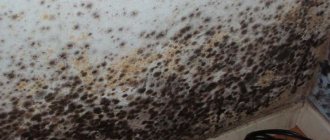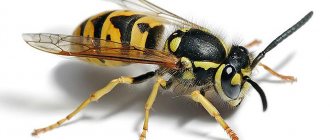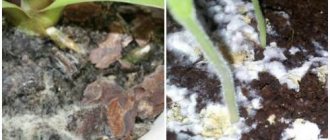How dangerous is black mold in the house for the human body and how to get rid of it is a complex question that worries many people. After all, some residents have to periodically deal with the appearance of black mold fungi in their own apartment or private house. It is extremely unpleasant to see colonies of fungi on products that have been lying on the shelf for a long time, or on the walls in the bathroom and other rooms.
This problem should be dealt with immediately, because mold provokes various diseases in family members. However, it is not possible to do this quickly in all cases, but you also cannot leave the problem without a solution. In order to find the best way to get rid of the scourge, we will look at the dangerous consequences of fungi, what types most often appear in apartments and how to deal with them yourself.
How dangerous is black mold in the house for the human body and how to get rid of it?
What types of black mold are there?
If you don’t look closely, at first glance it will seem that traces of mold are ordinary dirt that can be quickly removed. However, this is not the case at all.
Expert opinion: Masalsky A.V.
Editor of the “construction” category on the Stroyday.ru portal. Specialist in engineering systems and drainage.
Mold plaque is multiple colonies of small fungi that settle on almost any surface. In addition, they differ in types, so before starting the fight, it is necessary to consider them in detail.
Black aspergillus
This is a microscopic organism that actively spreads in places where moisture accumulates: in the bathroom, in the kitchen, in a room with a swimming pool. Often fungi can be found in the air humidifier, on the rubber seal near the drum of the washing machine.
Colonies of black mold actively spread on floors that come into contact with water (walls, ceilings), as well as on cardboard book covers and flower pots. However, the main place where spores accumulate is between the tiles in the bathroom or toilet.
Fungus in macro zoom
If you examine colonies of fungi under a microscope, you will notice that they look harmless. However, they not only undermine human health, but can also cause death.
If there are spores on surfaces or any objects indoors, they continue to spread through the air. This means that fungi quickly settle on our food and personal belongings. In addition, apartment residents and pets inhale these microorganisms in the air every day, which is why they accumulate in the respiratory system.
Even if at first you do not notice any dangerous consequences, then after a few months or years this will lead to serious illnesses:
- inflammation of the membranes of the brain;
- myocarditis;
- bronchitis or pneumonia;
- irritation of the nasal mucosa.
Cases have been reported where excessive accumulation of fungal spores has caused the formation of papillomas and even cancer cells. If, with one breath, a huge amount of spores penetrates a person’s lungs, he may experience toxic damage to the body. In the presence of weak protective functions (which is common among the population), this will inevitably lead to death.
It is the spores of this fungus that provoke the disease - aspergilloma of lung tissue. Thus, fungal spores first enter the nasopharynx, then move to the bronchi and other respiratory organs.
The main danger is that disputes are developing rapidly
The vital activity of colonies contributes to the release of dangerous substances, due to which necrotic foci form on the tissues. Over time, these lesions increase in size and lung tissue dies, causing suffocation and death.
Fuming Aspergillus
This is also a dangerous type of fungus, the main difference of which is its resistance to high temperatures (up to 60 degrees). Such fungi have microscopic spores, their size is less than 2.5 microns, so they enter the respiratory tract with air currents.
It is worth noting that people with strong immunity can breathe air saturated with fungal spores every day, which will not cause dire consequences. However, not every person can now boast of ideal health, so inhaling spores is extremely dangerous for people with reduced protective functions of the body.
The risk of an increase in the number of patients increases when repair work is carried out near hospitals, because in hospitals there are patients with poor health, whose bodies are vulnerable to any negative impact. Therefore, in such situations, the air is checked for the presence of fungal spores.
This is what colonies of fungi look like when they were grown on a plate in a laboratory study - as a rule, the spores have a greenish tint
Green mold rapidly spreads on the fruits of fruit trees, in places of damage. If you notice that mold quickly forms on your bread, then most likely the flour was made from affected grain.
The main danger of fungi of this type is that they accumulate in the human body and then provoke various types of allergic reactions. In addition, when entering the hematopoietic system, the spores destroy red blood cells. Increased intoxication of the body prevents the strengthening of the immune system.
Alternaria
This is another equally dangerous type of mold. Colonies of these fungi can have different appearances - this also depends on the environment in which they settle. Often dark spots appear on surfaces, but sometimes they have a different shade.
Almost always, these are the fungi that settle on vegetation. You can find them on fallen leaves in the fall, as well as on vegetables and fruits that have been lying on the shelf for a long time. In addition, spores are formed on the soil cover.
It is worth noting that such fungi appear on any food product, even meat. In addition, they are distributed on fabrics of natural origin. Toxic secretions of fungi poison and destroy seedlings, including grain crops.
Affected bulbs
Almost every person has seen vegetables on store shelves that have mold on them, and therefore you should not bring such a source of fungi into your apartment.
In timber houses, spores spread faster than in structures made of concrete or brick. They reproduce in the presence of heat and slight humidity. Direct damage is observed through direct contact with mold spores, however, poisoning can also be caused by toxic waste products of colonies.
Toxic substances provoke the development of bronchitis, asthma, and skin rashes. In addition, fungal spores cause the development of an allergic reaction in people who are sensitive to them.
Toxic substances provoke the development of bronchitis
Health Hazard
The most common symptoms associated with the appearance of mold are muscle and joint pain, skin diseases, runny nose, difficulty breathing, lethargy, apathy, and fatigue. Fungi often cause damage to various internal organs. The spores cause irritation to the skin, eyes, and mucous membranes. Often numbness of the extremities and inflammation of the joints of the spine (ankylosing spondylitis) begin to develop.
Molds cause irritability, anxiety, chronic insomnia, and frequent headaches. They are extremely dangerous for pregnant women, as they lead to impaired fetal development. Malignant tumors, necrosis, kidney damage are the result of long-term influence of fungi and their microscopic spores. The most common diseases caused by exposure to black mold are:
- muscle pain;
- fatigue, weakness;
- sinusitis, rhinitis;
- headache;
- depression, anxiety, restlessness;
- insomnia;
- frequent dizziness;
- inflammatory diseases of the throat;
- disruption of the gastrointestinal tract;
- rash.
The body of a healthy person is reliably protected from the toxic effects of black mold. But any minor illness or surgery weakens the immune system. In such cases, the body becomes extremely susceptible to mold spores. Allergy sufferers will be the first to feel worse. Coughing, asthma attacks, and various skin rashes will appear. People who do not suffer from allergies may not immediately notice the harmful effects. This does not mean that the insidious microorganism does not have a destructive effect.
What promotes the growth of fungi?
We only looked at the risk of mold spreading. However, in order to get rid of this problem, it is necessary to become familiar with the reasons why microorganisms multiply. It is necessary to find out which ways the spores get inside in order to carry out control measures in a timely manner.
Expert opinion: Masalsky A.V.
Editor of the “construction” category on the Stroyday.ru portal. Specialist in engineering systems and drainage.
Heat and moisture are factors that promote the proliferation of microorganisms. Active growth of colonies often occurs at air humidity above 75% and temperatures from 20 to 30 degrees. If the room is not yet properly ventilated, colonies will spread much faster.
It can be much easier to prevent mold from appearing than to deal with the consequences of this scourge.
Moreover, in order to eliminate dangerous causes, no financial investments will be required, because even basic ventilation of the room can save the situation.
There are other factors influencing this process that are usually ignored. So, it is obvious that the problem has increased with the advent of new technologies for construction work.
Plastic windows and doors
Now almost all owners of apartments and private houses are switching to plastic windows, because such structures provide sound insulation compared to their wooden counterparts.
In addition, plastic windows retain heat in the room in the best way and do not require complex maintenance. As a rule, plastic structures are characterized by long-term operation. However, improper installation and continued use of plastic windows leads to the spread of mold.
Often fumes accumulate on window glass if they are installed by an unqualified technician.
The peculiarity is that such structures are closed hermetically, this in turn disrupts the air circulation that exists in the presence of wooden structures. In addition, condensation on the surface accumulates even if the number of glasses is incorrectly selected, poor-quality materials, or violations during the installation process.
This means that the presence of plastic windows or doors increases indoor humidity. However, window manufacturers anticipated this problem and created a special ventilation valve. Therefore, regardless of the time of year, it is recommended to ventilate the room, otherwise it will not be possible to avoid the accumulation of fungal colonies.
In a special article we will tell you why plastic windows fog up inside and can this be avoided?
Consequences of excessive dampness - mold spots on slopes and walls
Plasterboard panels
This building material is preferred by many craftsmen, because its use allows you to finish even an uneven wall. In addition, such panels are used to make shaped partitions and various structures with horizontal and vertical elements.
Therefore, in order not to turn the room into a real “breeding ground” for mold, it is necessary to adhere to the installation rules. So, when finishing the panels, you should wait time for the plaster to dry.
Expert opinion: Masalsky A.V.
Editor of the “construction” category on the Stroyday.ru portal. Specialist in engineering systems and drainage.
If you are going to use plasterboard to finish a room with a high level of humidity, then you need to choose panels that are suitable for such conditions. In addition, during the finishing process, primer and plaster with the addition of antiseptics should be used.
When making plasterboard structures, it should be taken into account that this material absorbs moisture, which lingers inside for a long time
Poor ventilation
It is quite rare that windows are installed indoors in a plumbing unit, but in addition, there is often no normal ventilation there. Because of this, there is an excessive level of moisture inside, because a bath, shower, washing machine, clothes dryer and towels are installed there - natural ventilation is clearly not enough here.
All that remains is to install a high-quality exhaust system. This will solve the existing mold problem and also prevent it from recurring.
Constant contact of floors with water causes rapid growth of fungal colonies
Floor humidity
There are often situations when, when creating a project for an apartment or private building, the point of formation of evaporation on the floors is not taken into account. This leads to the fact that during heavy rains or cold weather the walls freeze and become damp. Over time, mold colonies will spread on surfaces.
The danger is that at first the fungi appear from the outside, but after a while they rush into the depths of the ceiling and grow inside. The process occurs much faster when there is damage and microcracks on the walls.
Often the source of fungi is the basement, where there is high humidity at any time of the year. From there, the spores spread to other rooms through ventilation.
If we are talking about your own home, then you need to take care of creating reliable ventilation yourself. When the source of mold is the basement of a multi-story building, you should contact the housing office employees.
The presence of multiple colonies of black mold contributes to the weakening of load-bearing walls, therefore there is a risk of destruction
Prevention after treatment
Dealing with harmful mold of any kind is a long process that requires a lot of labor. It is much easier to take measures to prevent the appearance of plaque on surfaces in the house:
- regularly ventilate all rooms, especially the bathroom and toilet;
- clean your home thoroughly and periodically disinfect it;
- monitor humidity, take an interest in this indicator in neighboring apartments, common basements;
- prevent the formation of condensation on windows, walls and doors;
- waterproof the basement if it is very wet;
- treat the surfaces with special antifungal agents;
- insulate the room when it freezes in the cold season.
How to deal with black mold?
If you find even a slight build-up of mold in your apartment, you should immediately begin to combat the problem. Otherwise, you risk missing the time during which the disputes will have time to spread further.
Most often, housewives use special antifungal drugs that can be found in the store. They already contain components that prevent the formation of mold. This category includes the following products: “ABEDIS 06”, “Dali”, “Ceresit” .
An ultraviolet lamp helps get rid of various types of fungi. Just before you turn on this device, you should make sure that there are no people, animals or plants in the room.
A UV lamp destroys fungal spores in any quantity, because it’s not for nothing that they settle outdoors only in the shade
Expert opinion: Masalsky A.V.
Editor of the “construction” category on the Stroyday.ru portal. Specialist in engineering systems and drainage.
If there is mold on any items, they must be removed from the apartment and disposed of. When fungi accumulate on smooth surfaces (glass, tiles), the problem can be dealt with using folk remedies, which we will consider in more detail.
Table 1. Traditional recipes for mold.
| Remedy, illustration | Mode of application |
| A non-toxic product that can be found in the kitchen of every apartment. It is enough to dissolve soda with water and spray the surface with a spray bottle, and then wipe with a cloth. |
| It is necessary to apply acid to the surface with fungi without adding water, leave for several hours, and then rinse off. |
| It is necessary to take the substance (2.5%), treat the affected surface, and after 5-6 hours rinse with water. |
| You need to add about 12 ml of oil to a glass of water, then pour this solution into a spray bottle and spray the surface. To achieve a positive result, it is recommended to carry out the procedure 3-4 times. |
Video - Traditional methods of fighting fungi
Two sides of the same green coin
Be it Alexander Fleming with his incredible bow tie and blue eyes, who made two of the most important discoveries for humanity due to his own negligence and sloppiness: first by sneezing into a Petri dish with bacteria, introducing snot into laboratory material and thus discovering lysozyme in 1922, and then , allowing dust and spores to enter the culture of staphylococcus he was studying, grew Penicillium rubens in 1929, inadvertently discovering the properties of penicillin. Or whether it was the Hospital Brotherhood of St. Anthony, which in the Middle Ages treated gangrenous lesions due to poisoning with sclerotia (the wintering form of the ergot species Claviceps purpurea) - ergotism or “St. Anthony’s fire.” In one case, mold saved millions of lives from painful death due to gangrene, sepsis and infections, in another it itself caused epidemics with tens of thousands of victims slowly rotting alive with the same gangrene and sepsis, going crazy from toxins, on the basis of which later, by the way , made LSD.
On the left is Alexander Fleming, on the right is the consequences of eating ergot, painting by Matthius Grünwald.
The evolutionary irony lies in the sheer ambiguity of mold. No matter what fluffy and slimy place in its taxonomy we poke the curious finger of a scientist, there are a million little “buts” everywhere. Almost always, as dangerous as it is, it is exactly as necessary. But what ScientaeVulgaris knows for sure is that fuzzy mushrooms of any kind can cause you problems.
At the height of the French Revolution of 1789, a young, handsome 22-year-old soldier begins to complain of severe facial pain in the cheekbone area. The initial examination showed the integrity of the teeth, and the guy was not allowed to cut them. Then exophthalmos was added to the facial pain: the right eye suddenly popped out of its socket. He was immediately sent to the hospital. Once in the field surgery department of those years, Jacques Thibault began to fear for his life. An operation was scheduled. His alveolar process was perforated. Based on the results of the operation, a fungal porous mass was discovered in the maxillary sinus. The doctor completely refused to cut it out due to severe bleeding and the inability to continue the operation due to its complexity. The guy was sewn back together with the mushroom and sent back from where he came.
18th century eye surgery manual and instrument set:
After 22 days, the strange tumor grew a little more, filling part of his mouth and the entire right nostril, beginning to cause difficulty swallowing and breathing. He is sent again to the hospital in Paris, where surgeons still remove and clean the mycelium. To prevent further growth, white cauterization is used.
Then there were three types: black, red and white. I’m telling you so that you understand the essence of the entire medical process. The names are given based on the glow colors of the metal tool. Chronic diseases of bones and joints were cauterized for blacks, and nerves (hysterical states) were treated. Red according to the instructions, light bleeding from the bone or hole after tooth extraction. Bright red for the treatment of fistulas, ulcers and purulent wounds. Jacques was prescribed white cauterization (by the way, they also treated prostatitis by inserting a white-hot needle into the prostate). Cauterizing the fungus helped Jacques for a while. But after a couple of weeks, new growths appeared on the back of the palate again. They were cauterized in the same way, the patient was observed and, since nothing else grew from him, they were discharged after 134 days. The further fate of the French soldier and his appearance after the operations are unknown. But de facto, he was the first recorded patient with a terrible problem caused by the fact that fungi of the genus Aspergillus fumigatus tried to eat him alive.
A hundred years before these events, back in 1729, the Italian priest and biologist Pier Antonio Micheli, while cataloging mold, noticed their curious similarity with aspergillus (Aspergillum, from Latin spargere - to spray) or, in Russian, with church sprinkling. And then in 1863, the Frenchman Georg W. Fresenius, while researching pulmonary lesions, divided the Aspergillus genus of molds into species, isolating from it fumigatus (from the Latin fumeus - smoky). Such a smoky sprinkle. Fumigatus is incredibly widespread in nature, its spores measuring only 2-3 microns are carried with every breath of fresh wind in every minute of the existence of life on earth for many millions of years.
Church sprinkling and mold of the same name:
By his calling, he is a saprotroph, like most other representatives of mold (saprós - “rotten” and trophē - “nutrition”), and professionally breaks down complex biological compounds of cells into simple ones, returning all kinds of organic carrion to the bosom of Mother Nature. Most of it can be found in compost, where there is an active process of decay of organic matter. The fungus can form two types of colonies: fluffy and velvety. Very tenacious and survives up to 70 degrees Celsius. Every day we inhale hundreds of its spores. But our immune system copes and successfully neutralizes the invading fungal pathogens. Then why did Jacques get sick?
TOP 10 best mold repellents
| Photo | Name | Rating | Price | |
| #1 | HG Mold Spray | ⭐ 4.95 / 5 1 - voice | Find out more | |
| #2 | Dali (Dali) | ⭐ 4.9 / 5 | Find out more | |
| #3 | Bagi Anti-mold | ⭐ 4.9 / 5 | Find out more | |
| #4 | Alpa Phongifluid | ⭐ 4.85 / 5 | Find out more | |
| #5 | Cillit BANG spray Black Mold | ⭐ 4.8 / 5 | Find out more | |
| #6 | Stop-Mold Olimp | ⭐ 4.75 / 5 | Find out more | |
| #7 | Abedis 06 | ⭐ 4.7 / 5 1 - voice | Find out more | |
| #8 | Neomid BIO Repair | ⭐ 4.65 / 5 | Find out more | |
| #9 | Belinka | ⭐ 4.6 / 5 | Find out more | |
| #10 | Eskaro Biotol Spray | ⭐ 4.55 / 5 | Find out more |
Which mold repellent would you choose or recommend?
Take the survey
Removing mold from floors: step-by-step instructions
It can be more difficult to deal with mold if the colonies spread on the surface of plaster or wallpaper, so this process should be considered in more detail.
Security measures
Step One: The first step is to remove the top layer of finish. This could be plaster or wallpaper.
Using a spatula or metal sponge, remove the layer of moldy plaster from the surface
Step two: Next, this wall must be thoroughly dried.
It is recommended to use an industrial hair dryer
Step three: after which it is necessary to thoroughly treat the surface where the mold and nearby areas were located using a spray bottle.
Apply antiseptic using a spray bottle
Step four: all that remains is to wait for the wall to dry, and then apply primer and putty.
Applying finishing touches to the walls
Video - Getting rid of fungus on the walls
Reasons for appearance
In order to understand how to deal with black mold, you should find out and eliminate the cause of its appearance.
Causes:
- Increased humidity in the room.
- Ground dampness.
- Leaking pipes.
- Poor heating.
- Freezing of brick or concrete.
It can occur as a result of improper wallpapering. If you paste wallpaper on still fresh plaster, this will create favorable conditions for the growth of fungus. It can appear almost anywhere, on walls, ceilings, in the basement, but most often it can be found in the bathroom or shower stall due to high humidity.
Poll: what is the best mold repellent?
Which mold repellent would you choose or recommend?
HG Mold Spray
50.00 % ( 1 )
Dali (Dali)
0.00 % ( 0 )
Bagi Anti-mold
0.00 % ( 0 )
Alpa Phongifluid
0.00 % ( 0 )
Cillit BANG spray Black Mold
0.00 % ( 0 )
Stop-Mold Olimp
0.00 % ( 0 )
Abedis 06
50.00 % ( 1 )
Neomid BIO Repair
0.00 % ( 0 )
Belinka
0.00 % ( 0 )
Ways to fight
Nowadays, there are many ways to get rid of dark spots, so this is no longer a serious problem. Many special substances have been created against such a fungus, but traditional methods have not lost their relevance. The method of getting rid of mycelium is selected depending on their habitat. It is especially important to clean the contaminated surfaces of carpets and furniture, as these are the surfaces that people come into contact with on a daily basis.
Fungicidal preparations
In advanced cases, when mold has affected a large surface or its spores have penetrated deep into materials, you will have to seek help from special fungicidal preparations produced by the chemical industry. These are various antifungal agents designed to destroy the fungus or prevent its occurrence. Their range is wide, and you can purchase products of this kind at any hardware or hardware store.
Before purchasing fungicidal compounds, you must carefully read the instructions so as not to make a mistake in your choice, since they differ in purpose, method of application and type of surfaces to be treated. For example, the QUELYD Anti-Mold product is available in two versions: for removing mold in living rooms and bedrooms or in bathrooms and toilets. Both drugs are suitable for sanitation and repair.
Biodom, SANATEX, PROSEPT FUNGI STOP will help as an emergency aid. They successfully fight various types of mold, moss and lichen and can be used on almost all building materials: concrete, brick, wood, slate, plaster, granite, tiles and even wallpaper.
